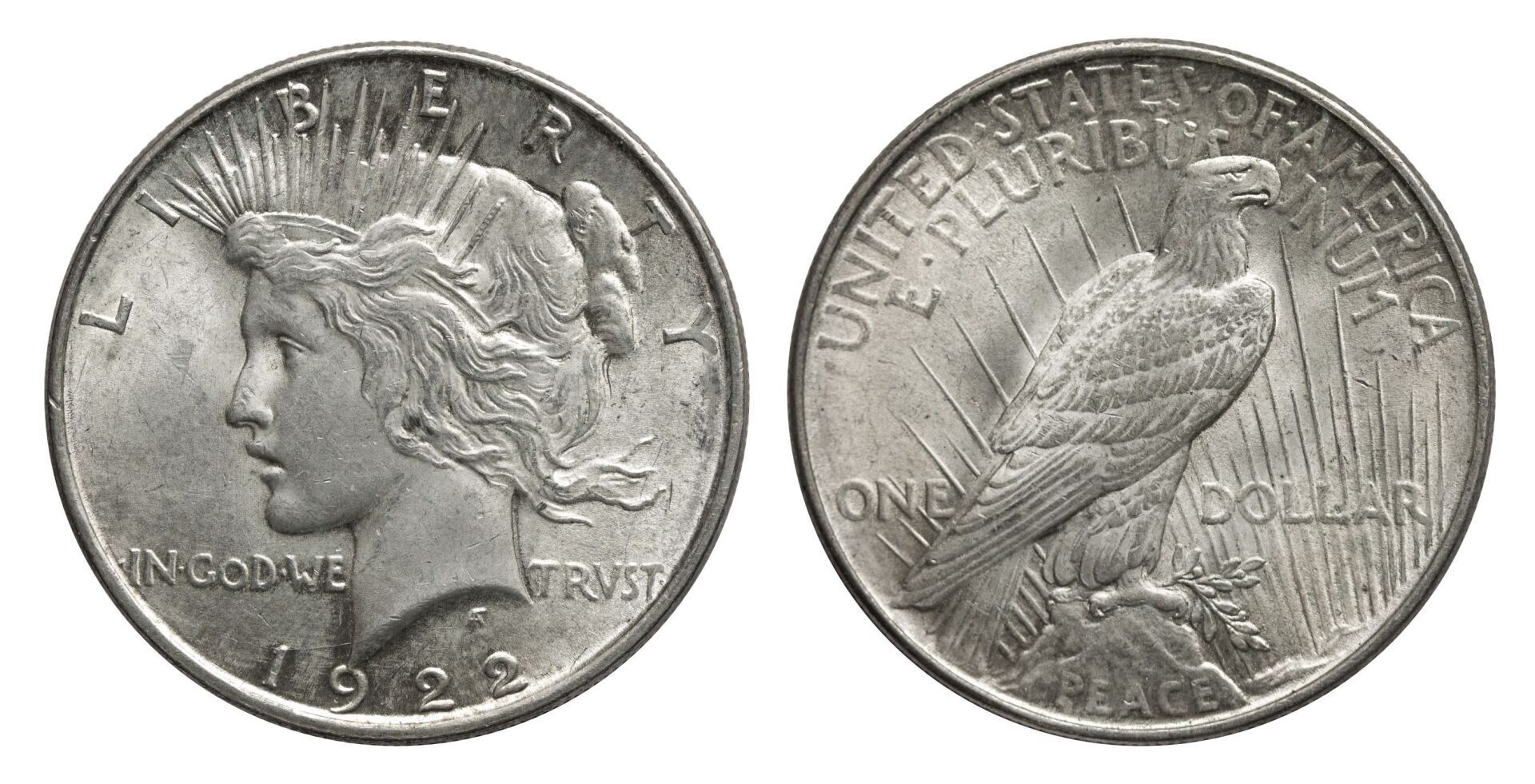The Peace Dollar
Minted 1921-1928, with special issues in 1834,1835, and 2021
In 1918, The Pittman Act was signed, requiring the United States Mint to strike millions of silver dollars. What exactly was the Pittman Act? We’ll get to that I promise! In 1921, the first of those silver dollars was released.
The Mint initially used the Morgan silver dollar design for the coins, but following the end of World War I, the people wanted a coin to commemorate the peace of the end of the war. The Peace Dollar was approved by Treasury Secretary Andrew Mellon, and released into circulation in January of 1922.
The Pittman Act
The Pittman Act is the number one reason we as coin collectors get to collect and appreciate the Peace Dollars!
This Act came about as a response to rising silver prices, which was caused by Germany attempting to destabilize British rule in India.
They did this by spreading rumors that the British were no longer able to exchange silver for the paper currency they had printed. This caused hoarding of silver, and the price of silver began to skyrocket.
The British government turned to the United States for aid, hoping to purchase silver in order to increase the supply of silver in India, and subsequently lower the price and demand.
The U.S. obliged with the Pittman Act in 1918; this statute allowed the U.S. to sell silver to the British.
Since Morgan silver dollars hadn’t been circulating as heavily anymore in the U.S., there was quite a surplus in the treasury.
About 47% of all Morgan Silver dollars that had been struck up to that year were melted down and sold to the British.
Many of these melted Morgan silver dollars were then minted into the Indian Rupee,
so if you ever come across an Indian Rupee from 1919 or 1920, it was probably a Morgan silver dollar in its previous life!
The other part of the Pittman Act, required the U.S. to replace all those silver dollars that were melted down and sold to the British. The Act also required that the silver be purchased
exclusively from American Mining Companies.
Lobbying for the Peace Dollar
In August of 1920, a paper titled “Commemorate the peace with a coin for circulation” by Farran Zerbe, was read at the annual ANA convention in Chicago, Illinois. It called for a coin to celebrate peace, here’s an excerpt from Farran Zerbe’s paper,
“I do not want to be misunderstood as favoring the silver dollar for the peace coin, but if coinage of silver dollars is to be resumed in the immediate future, a new design is probable and desirable, bullion for the purpose is being provided, law for the coinage exists and limitation of the quantity is fixed--all factors that help pave the way for peace coin advocates. And then--we gave our silver dollars to help win the war, we restore them in commemoration of victory and peace.”
This was so well received at the convention that it led to a committee being formed in order to submit the proposal to Congress. According to Walter Breen, “Apparently, this was the first time that a coin collector ever wielded enough political clout to influence not only the Bureau of the Mint, but Congress as well.”
Unfortunately the bill didn’t make it past Congress.
But it doesn’t end there!
Advocates for the peace coin soon
realized that Congressional approval was not even necessary! The Morgan silver dollar had been struck for more than 25 years, meaning it was actually eligible for replacement. The only approval needed was the Secretary of the Treasury.
The replacement was approved, and work began on organizing a competition for the design.
The Design Competition Begins
Open only to invited sculptors, the winner of the competition would receive $1,500 in prize money, and all other participants would receive $100 each. Some of the participants in the competition included notable sculptors such as Hermon MacNeil, Victor D. Brenner, and even Adolph Weinman, sculptor of the
Walking Liberty half dollar! (His design went on to be struck on the Silver Eagle!)
The specifications given to all the artists for the coin design were as follows;
the obverse must depict the head of Liberty, and to be made “as beautiful and full of character as possible”, and the reverse had to feature an eagle, as that was mandated by the Coinage Act of 1792.
The coin also of course must display all the standard inscriptions; denomination, name of the country, the word “Liberty”, and both mottos “E Pluribus Unum” (Out of many, one) and “In God We Trust” Those were the only stipulations, otherwise everything else was left up to the artists to design.
On December 13, 1921 all designs were reviewed and an
absolute unanimous decision was made for Anthony de Francisci’s design was made.
Designing the Peace Dollar
The Obverse of the Peace dollar features the Lady Liberty, facing left, a
radiate crown atop her head, meant to represent the crown on the Statue of Liberty. The word “LIBERTY” frames her head in an arc around the coin, and the motto “In God We Trust” is towards the bottom of the design on either side of her slender neck.
Francisci based his design of Liberty on his wife Teresa.
Teresa was absolutely over the moon about being portrayed as Lady Liberty, in a letter to her brother she wrote,
“You remember how I was always posing as Liberty, and how broken-hearted I was when some other little girl was selected to play the role in the patriotic exercises in school? I thought of those days often while sitting as a model for Tony’s design, and now seeing myself as Miss Liberty on the new coin, it seems like the realization of my fondest childhood dream.”
When asked about his wife Teresa modeling for the coin, Francisci recalled that he opened the window of the studio and let the wind blow on his wife’s hair as he worked, inspiring the windswept look of the hair on Lady Liberty on the Peace dollar. He also did not feel that the design depicted his wife exclusively stating “the nose, the fullness of the mouth are much like my wife’s, although the whole face has been elongated.”
For the reverse, Francisci had submitted two designs; one featured a warlike eagle, breaking a sword, and the second was an eagle at rest holding an olive branch. The second design ended up forming the basis for the final reverse design.
Public Dislike for the Reverse Design
After Francisci had been chosen, a Mint press release described the reverse “a large figure of an eagle perched on a broken sword, and clutching an olive branch bearing the word ‘peace’”.
Shortly after, the New York Herald released a scathing review of the new design, claiming
“If the artist had sheathed the blade or blunted it there could be no objection. Sheathing is symbolic of peace of course; the blunted sword implies mercy. But a broken sword carries with it only unpleasant associations. A sword is broken when its owner has disgraced himself. It is broken when a battle is lost and breaking is the alternative to surrendering. A sword is broken when the man who wears it can no longer render allegiance to his sovereign. But America has not broken its sword. It has not been cashiered or beaten; it has not lost allegiance to itself. The blade is bright and keen and wholly dependable. It is regrettable that the artist should have made such an error in symbolism. The sword is emblematic of Justice as well as strength. Let not the world be deceived by this new dollar. The American effort to limit armament and to prevent war or at least reduce its horror does not mean that our sword is broken.”
Obviously people were not happy about the broken sword being featured on the coin. Feeling that it represented weakness and defeat. Given the horrors of the Great War, Americans at the time were rather sensitive about national symbols, and quite unwilling to allow artists any freedom in interpretation.
The Mint, the Treasury, and the Fine Arts Commission very quickly began to receive tons of angry letters from the public against the design for the new Peace Dollar.
The design was quickly changed by Chief Engraver George T. Morgan, who had to painstakingly alter the die by hand at that point. He removed the sword, added more olive branches, and strengthened the rays behind the eagle to make it all look more natural. He truly did an excellent job as well. The Mint made another press release on December 24, stating that the broken sword would not be featured on the new coin.
Striking began shortly after, and the new Peace Dollar was first released into circulation on January 3, 1922.
The coin was very well received, and one Philadelphia newspaper said
“Liberty is getting younger. Take it from the new ‘Peace Dollar’, put into circulation yesterday, the young woman who has been adorning silver currency for many years, never looked better than in the ‘cart wheel’ that the Philadelphia Mint has just started to turn out. The young lady, moreover, has lost her Greek profile. Helenic beauty seems to have been superseded by the newer ‘flapper’ type.”


